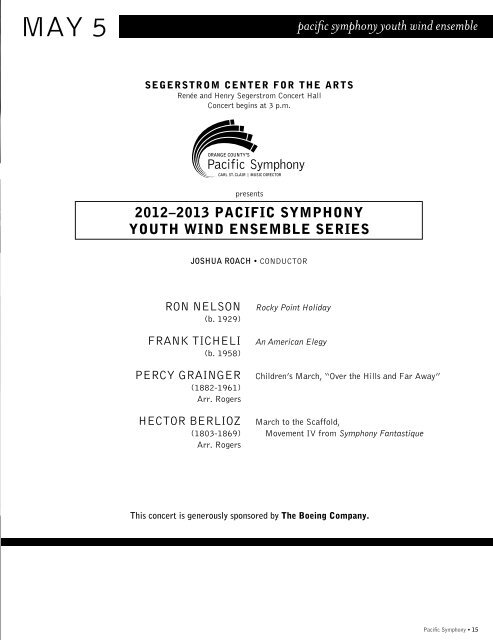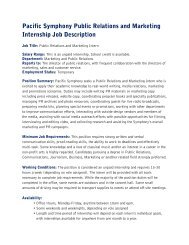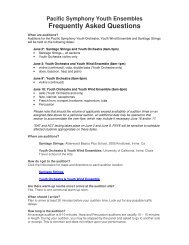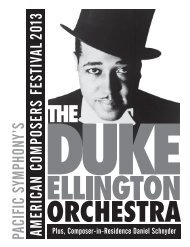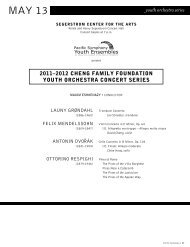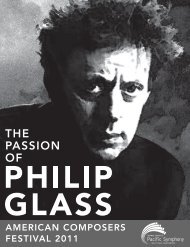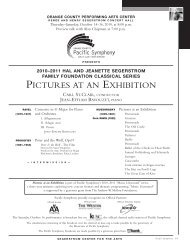You also want an ePaper? Increase the reach of your titles
YUMPU automatically turns print PDFs into web optimized ePapers that Google loves.
MAY 5<br />
pacific symphony youth wind ensemble<br />
SEGERSTROM CENTER FOR THE ARTS<br />
Renée and Henry Segerstrom Concert Hall<br />
Concert begins at 3 p.m.<br />
presents<br />
2012–2013 <strong>Pacific</strong> <strong>Symphony</strong><br />
Youth Wind Ensemble SERIES<br />
Joshua Roach • conductor<br />
Ron Nelson<br />
(b. 1929)<br />
Frank Ticheli<br />
(b. 1958)<br />
Percy Grainger<br />
(1882-1961)<br />
Arr. Rogers<br />
Rocky Point Holiday<br />
An American Elegy<br />
Children’s March, “Over the Hills and Far Away”<br />
Hector Berlioz<br />
March to the Scaffold,<br />
(1803-1869) Movement IV from <strong>Symphony</strong> Fantastique<br />
Arr. Rogers<br />
This concert is generously sponsored by The Boeing Company.<br />
<strong>Pacific</strong> <strong>Symphony</strong> • 15
NOTES<br />
Ron Nelson<br />
(b. 1929)<br />
A<br />
native of Joliet, Ill., Ron Nelson (b. 1929) attended the<br />
prestigious Eastman School of Music in Rochester, N.Y.,<br />
where he received his bachelor’s degree in composition. After<br />
graduating from Eastman, Nelson received a Fulbright Grant, which<br />
enabled him to study at the Paris Conservatoire. Among the most<br />
prestigious of his numerous awards and achievements has been<br />
receiving the Acuff Chair of Excellence in the Performing Arts in<br />
1991. Esteemed American conductor Leonard Slatkin has described<br />
Nelson as “the quintessential American composer. He has the ability<br />
to move between conservative and newer styles with ease. The fact<br />
that he’s a little hard to categorize is what makes him interesting.<br />
This quality has helped Nelson gain wide recognition as a composer.”<br />
Composed in 1966 and published in 1969, Rocky Point Holiday was<br />
one of Nelson’s first compositions to earn him a prestigious place at<br />
the forefront of American wind band music. The work was composed<br />
while Nelson was on summer vacation at Rocky Point, an amusement<br />
park and seaside resort on Narragansett Bay in Rhode Island<br />
(halfway between Newport and Providence). The piece was written<br />
for a band tour of the Soviet Union by the University of Minnesota<br />
Band. Specifically written to be a technically demanding show piece,<br />
it is extremely difficult and features a wide variety of instrumental<br />
techniques and challenges. Firmly established in the repertoire, the<br />
piece helped cement Nelson’s reputation as a composer of virtuoso<br />
band music. His music is often featured on concert programs and in<br />
competitions.<br />
Beginning with a brass fanfare, the piece features lively rhythms and<br />
ostinato-like textures. Overall, the mood is jubilant and fun, capturing<br />
the carefree excitement of seaside resort, ocean breezes, roller<br />
coasters and summer crowds. It has a particularly thick texture, which<br />
is occasionally punctuated by lyrical interludes. The lively carnival<br />
atmosphere builds slowly and steadily to a rousing climax.<br />
by joshua grayson<br />
A<br />
professor of composition at the USC Thornton School of<br />
Music since 1991, Frank Ticheli (b.1958) has composed<br />
music in a wide variety of forms and genres. Much of his music<br />
for wind band has become part of the standard repertoire. Having<br />
spent the earliest part of his childhood in Louisiana, Ticheli now<br />
lists Cajun, Creole, New Orleans jazz and Southern Folk music as<br />
some of his most important influences. A native of Monroe, La., his<br />
initial exposure to music was New Orleans jazz. After relocating to<br />
suburban Dallas at the age of 13, he became exposed to band music<br />
at his high school’s award-winning music program. These two early<br />
influences can be heard in many of his award-winning compositions.<br />
Through the public school system, Ticheli gained an appreciation for<br />
the inherent potentials of wind band music. Ever since then, he has<br />
been fascinated by instrumental colors. He often utilizes transparent,<br />
pure colors, carefully avoiding the overuse of tutti. In nearly all of<br />
his music, Ticheli aims for transparency of texture and pureness<br />
of tone color, saving full tutti for rare occasions. Explaining his<br />
philosophy of orchestration, he has remarked:<br />
To be certain, carefully written color combinations can<br />
produce unique and beautiful results, and well-mixed colors<br />
are usually a necessity during a strong climax. But constant<br />
doubling weighs down a piece and reduces its expressive<br />
potential. Unfortunately, this sound is so prevalent in band<br />
music that many listeners accept it as “the band sound.”<br />
I certainly understand one reason for the practice. Music<br />
educators, seeking ways to encourage greater confidence<br />
in their students, have been drawn to thick doublings as a<br />
kind of musical insurance policy. But ironically, this leads<br />
to a dependency-based relationship that ultimately keeps<br />
students down. I try to provide an alternative for young<br />
musicians by writing somewhat leaner, more transparent<br />
textures. When students are expected to carry the ball from<br />
time to time, they ultimately become more confident, more<br />
self-aware, and more sensitive.<br />
Frank Ticheli<br />
(b. 1958)<br />
16 • <strong>Pacific</strong> <strong>Symphony</strong>
NOTES<br />
Composed in 2000, the piece “American Elegy” was commissioned<br />
by the Alpha Iota Chapter of Kappa Kappa Psi at the University<br />
of Colorado. It was written as a memorial for the tragedy which<br />
occurred at Columbine High School in Littleton, Colo. on April 20,<br />
1999. In one of the worst acts of homegrown violence in America’s<br />
history, two students at Columbine High School committed a<br />
shooting rampage on their fellow students, resulting in 13 deaths and<br />
24 injuries. The attack sparked a national debate on issues such as<br />
gun control, the role of violence in the entertainment industry, the<br />
causes of mental illness and the value of mediation.<br />
Ticheli conceived of this piece an expression of hope and strength in<br />
the face of adversity. In spite of the terrible situation, victims, family<br />
and bystanders were able to come together and show tremendous<br />
heroism and bravery. In his own words, the piece “is offered as a<br />
tribute to their great strength and courage in the face of a terrible<br />
tragedy. I hope the work can also serve as one reminder of how<br />
fragile and precious life is and how intimately connected we all are<br />
as human beings.”<br />
The work expresses three distinct moods: hope, serenity and sadness.<br />
Beginning with a shimmering glow from the depths of the band, it<br />
soon emerges and grows into hope. The piece is smooth and lyrical<br />
throughout, and offers a poignant commentary on national trauma<br />
and healing.<br />
PERCY GRAINGER<br />
(1882-1961)<br />
Born in Australia, Percy Grainger (1882-1961) was perhaps<br />
one of the 20th century’s most idiosyncratic composers. After<br />
spending his youth in the city of Melbourne, he moved to<br />
Germany in 1895 to study at the conservatory in Frankfurt. After<br />
several years of study he settled in London in 1901, where he lived<br />
until the outbreak of World War 1. Upon the onset of violence,<br />
Grainger left Europe and settled in the United States, where he lived<br />
for the remainder of his life.<br />
Grainger maintained a lifelong interest in folk music, particularly<br />
English and Scandinavian. During his decade in England, he<br />
maintained friendships with composers such as Delius and Grieg<br />
whose interest in folk music mirrored his own. He spent a good deal<br />
of time collecting, recording and transcribing folk songs. While living<br />
in England, he participated in the English folk music revival of the<br />
early decades of the 20th century, which also influenced composers<br />
such as Ralph Vaughan Williams. Although he is best known today<br />
for his arrangement of the traditional English folk song “Country<br />
Gardens,” he also composed a good deal of original music, most of<br />
which was experimental and highly unusual. The great majority of<br />
his works are of relatively short duration, and unlike many other<br />
classical composers, he sought to achieve continuity and sameness in<br />
his works rather than contrast and form.<br />
Children’s March: Over the Hills and Far Away was completed in<br />
1918 while Grainger was an oboist in the U.S. Coast Guard Artillery<br />
Band. The piece is imbued with a jolly folk character and has a<br />
charmingly playful sing-song character. Its rhythmic patterns are<br />
decidedly influenced by the English folk melodies Grainger loved.<br />
Melodically based, the piece features a great deal of repetition and<br />
little variation or development. While the melodies sound strikingly<br />
folk oriented, Grainger crafted them himself rather than quoting<br />
actual folk music.<br />
Born in a small town in southeastern France, Hector Berlioz<br />
(1803-1869) represents a unique and highly polarized time<br />
in the history of music. During the 19th century, composers<br />
began writing two distinct types of music. The first, “absolute<br />
music,” was merely about the music itself. Although it could convey<br />
very strong and powerful emotions, the music was ultimately about<br />
its melodies, harmonies, rhythms and instrumentation. By contrast,<br />
“program music” was meant to convey a story, landscape or other<br />
idea from outside the music. For his part, Berlioz was perhaps the<br />
greatest proponent of program music.<br />
Composed in 1830, Symphonie Fantastique consists of five<br />
movements, each telling part of a story. Berlioz made it abundantly<br />
clear that the audience needed to be informed of the storyline in<br />
order to fully understand his symphony, so he supplied his own<br />
descriptions for the work. At the beginning, represented by the first<br />
movement, the main character, an artist, sees a beautiful woman<br />
from afar and immediately falls in love with her at first sight. The<br />
woman is represented musically by a particular melody (called an<br />
idée fixe), which is repeated throughout all five movements of the<br />
piece. Upon discovering that the object of his love does not return<br />
his feelings, the artist despairs, and poisons himself with a powerful<br />
dose of narcotics (movement three). Berlioz’s own description of the<br />
fourth movement follows (translated by Michael Austin):<br />
Part Four: March to the Scaffold<br />
Convinced that his love is spurned, the artist poisons himself<br />
with opium. The dose of narcotic, while too weak to cause<br />
his death, plunges him into a heavy sleep accompanied by<br />
the strangest of visions. He dreams that he has killed his<br />
beloved, that he is condemned, led to the scaffold and is<br />
witnessing his own execution. The procession advances to<br />
the sound of a march that is sometimes sombre and wild,<br />
and sometimes brilliant and solemn, in which a dull sound<br />
of heavy footsteps follows without transition the loudest<br />
outbursts. At the end of the march, the first four bars of the<br />
idée fixe [a musical representation of the woman the artist<br />
loves] reappear like a final thought of love interrupted by<br />
the fatal blow.<br />
<strong>Pacific</strong> <strong>Symphony</strong> • 17
NOTES<br />
Hector Berlioz<br />
(1803-1869)<br />
What Berlioz does not mention in his annotation is the autobiographical<br />
element. Berlioz does not state that the “young artist” to which he<br />
refers is in fact himself. Several years before, the composer attended<br />
a performance of Hamlet, where he first encountered the young Irish<br />
actress Harriet Smithson, who played Ophelia. Enamored with her<br />
beauty, he began writing love letters to her, in spite of never having<br />
actually met. She chose not to respond; the hapless composer used<br />
the circumstance as inspiration to create this symphonic masterpiece.<br />
Once Ms. Smithson realized that she was the muse behind the<br />
composition, she agreed to meet Berlioz. The two were quickly engaged,<br />
and lived unhappily ever after until they divorced nine years later.<br />
While some of the plot elements may seem strange and quite bizarre,<br />
the dark, brooding, macabre elements of both program and music<br />
are well in keeping with literary and artistic movements of the time.<br />
For example, Mary Shelley’s Frankenstein (1818), John William<br />
Polidori’s The Vampyre (1819) and Edgar Allen Poe’s The Fall of<br />
the House of Usher (1839) all appeared within just over a decade of<br />
Symphonie Fantastique. To this day, the brooding, stormy qualities<br />
of the piece are beloved by audiences and musicians alike.<br />
Joshua Grayson is a Ph.D. candidate in historical musicology at the USC<br />
Thornton School of Music.<br />
Auditions<br />
Auditions for the <strong>Pacific</strong> <strong>Symphony</strong> Youth Ensembles 2013-14<br />
season are currently open!<br />
For eligibility and audition dates and requirements, please visit us<br />
online at www.<strong>Pacific</strong><strong>Symphony</strong>.org/psye.<br />
“Overall, as a parent, I can’t say enough about what the <strong>Pacific</strong> <strong>Symphony</strong> Youth<br />
Ensembles have meant to Matthew. The commitment by the staff and the board<br />
are amazing and the benefit to students is priceless.” — Patsy Jaimes, parent<br />
PSYO Season Finale<br />
Sunday, May 12, 3 p.m.<br />
Renée and Henry Segerstrom Concert Hall<br />
Help us welcome our new music director, Alejandro Gutiérrez,<br />
to the podium in his debut performance, as he leads PSYO in a<br />
rousing performance of Tchaikovsky’s <strong>Symphony</strong> No. 4!<br />
This performance also features our 2013 concerto competition<br />
winner, Justin Koga, performing Elgar’s Cello Concerto in E<br />
Minor.<br />
Tickets $12, general admission<br />
For tickets, visit www.<strong>Pacific</strong><strong>Symphony</strong>.org<br />
or call our box office at 714-755-5799.<br />
18 • <strong>Pacific</strong> <strong>Symphony</strong>
JOSHUA<br />
meet the music director<br />
T<br />
his year, Joshua Roach marks his third season as music director of <strong>Pacific</strong> <strong>Symphony</strong><br />
Youth Wind Ensemble (PSYWE). In addition to his conducting responsibilities with the<br />
PSYWE, he has served as the assistant/cover conductor for <strong>Pacific</strong> <strong>Symphony</strong> as well<br />
as Downey <strong>Symphony</strong>, Young Musicians Foundation Debut Orchestra and the University of<br />
Southern California (USC) Thornton <strong>Symphony</strong>. In 2011-12, he served as co-conductor of the<br />
USC Thornton Concert Orchestra and guest conducted the Thornton Chamber Orchestra.<br />
In 2011, Roach served as the assistant music director for <strong>Pacific</strong> <strong>Symphony</strong> Youth Orchestra in<br />
its debut tour to Bulgaria and later that year returned to conduct the Youth Orchestra’s widely<br />
publicized Rock <strong>Symphony</strong> performances with the Steve Miller Band in Corona and Temecula,<br />
Calif.<br />
In recent years, Roach has been very active, working as a music educator in a myriad of<br />
endeavors. For the past three years, Roach has taught for the Idyllwild Summer Arts music<br />
festivals and worked as an assistant conductor, large ensemble coach and trumpet teacher<br />
for the Idyllwild Festival High School Orchestra, Wind Ensemble and Chamberfest Chamber<br />
Orchestra. Roach also toured with the Irvine Young Concert Artists and participated as assistant<br />
conductor for the Landesjugendorchester of Baden-Württemberg, a highly selective youth<br />
orchestra in Southern Germany. Throughout the academic year, Roach performs clinics with<br />
visiting orchestras and wind ensembles from institutions throughout the United States and<br />
Canada.<br />
Roach also enjoys a rich and diverse life as a freelance musician and composer. He has been<br />
hired by companies such as Turner Classic Films, DreamWorks Pictures, Fox, PBS, the<br />
University of Arkansas Fort Smith, USA Network and various recording studio orchestras in<br />
Los Angeles. Over the years at USC, he has composed numerous short films. Most recently, his<br />
new composition, Overture Dodeca, was performed by the USC Thornton Concert Orchestra,<br />
Downey <strong>Symphony</strong> and PSYWE.<br />
An alumnus of the USC Thornton School of Music, Roach holds a bachelor’s degree in<br />
performance, a graduate certificate in scoring for motion picture and television and a master’s<br />
degree in instrumental conducting.<br />
Joshua Roach<br />
PSYWE Music Director<br />
<strong>Pacific</strong> <strong>Symphony</strong> • 19
ABOUT<br />
pacific symphony youth wind ensemble<br />
“My entrance into <strong>Pacific</strong> <strong>Symphony</strong> Youth Wind Ensemble was one of the most impactful occurrences in<br />
my career to date.” - Kevin Homma, alto and soprano saxophone<br />
Established in 2007, <strong>Pacific</strong> <strong>Symphony</strong> Youth Wind Ensemble (PSYWE) started under the<br />
direction of well-known music educator and recipient of the “Band Educator of the Year”<br />
award from the California Music Educators Association, Michael J. Corrigan, with support<br />
from Larry Woody and the Woody Youth Fund. In 2009, Joshua Roach, of the Thornton School<br />
of Music at USC, was appointed music director. Under Roach’s direction and unique enthusiasm,<br />
and with the artistic direction of <strong>Pacific</strong> <strong>Symphony</strong>’s renowned Music Director Carl St.Clair,<br />
PSYWE is quickly becoming the premier Youth Wind Ensemble in Orange County.<br />
Representing 23 schools in and beyond Orange County, PSYWE offers performance opportunities<br />
to instrumentalists in grades 8 through 12 and is one of three Youth Ensembles programs offered<br />
by <strong>Pacific</strong> <strong>Symphony</strong>. PSYWE provides members with a high quality and innovative artistic<br />
experience and strives to encourage musical and personal growth through the art of performance.<br />
Each season students enjoy an interaction with Maestro St.Clair, as well as regular interactions<br />
with guest artists and professional musicians of <strong>Pacific</strong> <strong>Symphony</strong>. Students also engage in<br />
an annual weekend retreat and are offered free and discounted tickets to <strong>Pacific</strong> <strong>Symphony</strong><br />
performances throughout the season. Members also enjoy an annual trip to the University of<br />
Southern California where the ensemble attends a concert presented by the USC Thornton Wind<br />
Ensemble.<br />
<strong>Pacific</strong> <strong>Symphony</strong> Youth<br />
Wind Ensemble<br />
Each season PSYWE presents a three-concert series. Performances commence at the Renée and<br />
Henry Segerstrom Concert Hall at the Segerstrom Center for the Arts as well as other high-quality<br />
community venues in Orange County.<br />
Rehearsals take place every Sunday afternoon from 2 – 5 p.m. in the music department at the<br />
University of California, Irvine, starting in September and ending in May each season. Members<br />
are selected through annual auditions which take place in June every year.<br />
<strong>Pacific</strong> <strong>Symphony</strong> Youth Ensembles (PSYE) is proud to partner with the Junior Chamber<br />
Music (JCM) as a resource for excellent chamber music training. Through JCM, PSYE<br />
has enjoyed nurturing two high-quality chamber ensembles who have delivered excellent<br />
performances for various events as representatives of PSYE!<br />
Junior Chamber Music<br />
Junior Chamber Music is a non-profit organization that brings together hundreds of talented<br />
young musicians from Southern California in a dynamic and diverse chamber music program. JCM<br />
is steadily expanding as one of the nation’s most vibrant youth chamber music programs providing<br />
music students the valuable opportunity to study the art of musical collaboration.<br />
Upcoming highlights for the 2013-14 Season include a tour to St. Petersburg, Russia, and the<br />
JCM-USC Chamber Music Competition at LACMA, as well as the JCM-AVSOMC Concerto<br />
Competition, master classes and informal chamber music workshops.<br />
Students audition in early October throughout Southern California. JCM matches students into<br />
small ensemble teams (2-5 players) according to level, age and location.<br />
20 • <strong>Pacific</strong> <strong>Symphony</strong>
MEET<br />
pacific symphony youth wind ensemble<br />
FLUTE<br />
Ronald Esteban, Principal<br />
Bridget Pei*, Assistant Principal<br />
Shreshta Aiyar*<br />
Jennifer Lee<br />
Shihang Li<br />
OBOE<br />
Rebecca Chung, Principal<br />
Amy Dong<br />
Jennifer (JiYeon) Lou<br />
Sophia Lou<br />
Clarinet<br />
Natasha Cuenco, Principal<br />
Rhonnel Agatep<br />
Melissa Chang<br />
Jae Choi<br />
Eliott Chung<br />
Harry Hwang<br />
Michael Hwang<br />
Nelson Liu<br />
BASS Clarinet<br />
Kristy Lai, Principal<br />
BASSOON<br />
Sydney Burke<br />
Amanda Chu<br />
Erika Lee<br />
Katie Miller<br />
Alto Saxophone<br />
Chris Bryant, Principal<br />
Jasmine Jan, Assistant Principal<br />
Timothy Huang<br />
Vincent Tao<br />
JOSHUA ROACH • MUSIC DIRECTOR<br />
2012–2013 Season<br />
Sections listed alphabetically under principals<br />
Tenor Saxophone<br />
Joshua Pan<br />
Ryan Swen<br />
Baritone Saxophone<br />
Shrey Chawla<br />
Horn<br />
Lily Homma, Principal<br />
Jonathan Selstad<br />
Jeremy Sogo<br />
Benjamin Stephan<br />
Noah Tingen<br />
trumpet<br />
Michael Choi, Principal<br />
Madison Chen<br />
Keita Dan<br />
Marc Jabara<br />
Minwoo (Tim) Park<br />
David Stephan<br />
Christopher Traynor<br />
Nathan Wilkes<br />
trombone<br />
Deanna Okajima, Principal<br />
John Park<br />
Cezar Tabrizy<br />
Cory Ye<br />
bass trombone<br />
Austin Major III<br />
euphonium<br />
Kathryn Donovan<br />
tuba<br />
James Elder, Principal<br />
Will Nazareno<br />
Brian Yu<br />
percussion<br />
Andrew Lee, Co-Principal<br />
Leela Safavi, Co-Principal<br />
Jessica Chu<br />
Janelle Hou<br />
Blake Stavros<br />
Sydney Gang<br />
double bass<br />
Sanjay Reddy<br />
harp<br />
Sydney Gang<br />
piano<br />
Alex Pham<br />
STAFF<br />
Patricia Walton<br />
Youth Wind Ensemble & Santiago Strings Manager<br />
* Piccolo<br />
Participating Schools<br />
Aliso Niguel High School<br />
Alvarado Intermediate School<br />
Arnold O. Beckman High School<br />
Capistrano Valley High School<br />
Cypress High School<br />
Diamond Bar High School<br />
Esperanza High School<br />
Fountain Valley High School<br />
Fred Newhart Middle School<br />
Irvine High School<br />
Laguna Hills High School<br />
Lakeside Middle School<br />
Newport Harbor High School<br />
Northwood High School<br />
Orange County High School of the Arts<br />
Oxford Academy<br />
Pioneer Middle School<br />
Rancho San Joaquin Middle School<br />
San Juan Hills High School<br />
Sierra Vista Middle School<br />
Tesoro High School<br />
Troy High School<br />
University High School<br />
Woodbridge High School<br />
<strong>Pacific</strong> <strong>Symphony</strong> • 21


